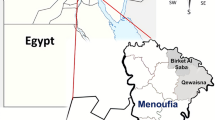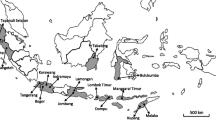Abstract
Babesia bovis is an important pathogen of bovine babesiosis and causes serious constraints on the health and productivity of domestic cattle in the tropical and subtropical areas of the world. Aiming to clarify the prevalence of B. bovis in China, a total of 2,364 cattle serum samples were randomly collected from 45 different areas of 17 provinces in China. Antibodies against B. bovis were tested by enzyme-linked immunosorbent assay (ELISA) using a recombinant C-terminal antigen of B. bovis rhoptry-associated protein-1 (RAP-1) to evaluate the prevalence of B. bovis. The results showed that the parasite was present in all of the investigated 17 provinces. The positive rate was from 6.40 to 47.27%, and the mean rate was 24.92%. These survey data will provide important information for designing control strategies for bovine babesiosis in China.
Similar content being viewed by others
References
Bai Q., Liu G.Y., Zhang L., Zhou J.Y. 1990. Discovery and isolation of Babesia ovata in China. Chinese Journal of Veterinary Science and Technology, (12), 2–5
Bock R., Jackson L., de Vos A., Jorgensen W. 2004. Babesiosis of cattle. Parasitology, 129, s247–s269. DOI: 10.1017/S00311 82004005190
Boonchit S., Xuan X.N., Yokoyama N., Goff W.L., Wagner G., Igarashi I. 2002. Evaluation of an enzyme-linked immunosorbent assay with recombinant rhoptry-associated protein-1 antigen of Babesia bovis for the detection of specific antibodies in cattle. Journal of Clinical Microbiology, 40, 3771–3775. DOI: 10.1128/JCM.40.10.3771-3775.2002
Boonchit S., Xuan X.N., Yokoyama N., Goff W.L., Waghela S.D., Wagner G., Igarashi I. 2004. Improved enzyme-linked immunosorbent assay using C-terminal truncated recombinant antigens of Babesia bovis rhoptry-associated protein-1 for detection of specific antibodies. Journal of Clinical Microbiology, 42, 1601–1604. DOI: 10.1128/JCM.42.4.1601-1604. 2004
Callow L.L. 1984. Piroplasms. In Animal Health in Australia, Protozoal and Rickettsial Diseases, vol. 5. Animal Health in Australia, pp. 121–160. Canberra, Australian Bureau of Animal Health, AGPS
Chen Z., Yang X.J., Bu F.J., Yang X.H., Yang X.L., Liu J.Z. 2010. Ticks (Acari: Ixodoidea: Argasidae, Ixodidae) of China. Experimental and Applied Acarology, 51, 393-40. DOI: 10.1007/s10493-010-9335-2
De Echaide S.T., Echaide I.E., Gaido A.B., Mangold A.J., Lugaresi C.I., Vanzini V.R., Guglielnone A.A. 1995. Evaluation of an enzyme-linked immunosorbent assay kit to detect Babesia bovis antibodies in cattle. Preventive Veterinary Medicine, 24, 277–283. DOI: 10.1016/0167-5877(95)00485-F
Dominguez M., Zabal O., Wilkowsky S., Echaide I., Torioni D.E., Asenzo G., Rodriguez A., Zamorano P., Farber M., Suarez C., Florin-christensen M. 2004. Use of a monoclonal antibody against Babesia bovis merozoite surface antigen-2c for the development of a competitive ELISA test. New York Academy of Sciences, 1026, 165–170. DOI: 10.1196/annals.1307.025
Goff W.L., McElwain T.F., Suarez C.E., Johnson W.C., Brown W.C., Norimine J., Knowles D.P. 2003. Competitive enzyme-linked immunosorbent assay based on a rhoptry-associated protein 1 epitope specifically identifies Babesia bovis-infected cattle. Clinical and Diagnostic Laboratory Immunology, 10, 1, 38–43. DOI: 10.1128/CDLI.10.1.38-43.2003
Jian Z.J., Ma S.Z., Yuan J.L., Shen J.Y., Lu W., Sun Q.Z., Miao Z.Q. 2011a Establishment of A GST-MSA-2C Fusion Protein Indirect ELISA Assay for Serodiagnosis of Babesia bovis. Xinjiang Agricultural Sciences, 48(1), 139–142
Jian Z.J., Ma S.Z., Sun Q.Z., Shen J.Y., Lu W., Miao Z.Q. 2011b. Epidemiologic Survey for Detection of Babesia bovis-Infected Cattle in XinJiang by an Improved MSA-2c Indirect ELISA Assay. Xinjiang Agricultural Sciences, 48, 2129–2133
Li A.Y., Liu A.H., Wang J.M., Zhu H., Ma M.L., Ren Q.Y., Guan G.Q., Luo J.X. 2013. Cloning and expression of C terminal for rhoptry-associated protein 1 of Babesia bovis. Chinese Veterinary Science, 43, 588–593
Li A.Y., Liu A.H., Wang J.M., Zhu H., Ma M.L., Ren Q.Y., Guan G.Q., Luo J.X. 2014. Development of ELISA for diagnosis of babesiosis in cattle. Chinese Veterinary Science, 44(01), 62–67
Liu Z.L., Zhao J.L., Ma L.H., Yao B.A. 1997. Babesia orientalis sp. nov. parasitized in buffalo Bubalus babalis in China (Piro-plasmida: Babesiidae). Acta Veterinaria Et Zootechnica Sinica, 28, 84–89
Lu W.S., Yin H., Luo J.X., Lu W.X., Zhang Q.C., Dou H.F. 1992a. Discovery of Babesia major in Xinjiang. In: Symposium of the 3rd Meeting of Chinese Society of Veterinary Parasitology, p. 220
Lu W.X., Lu W.S., Zhang Q.C., Dou H.F., Yin H., Luo J.X. 1992b. Survey of the species of tick-borne haemoprotozoan of cattle and feature in GanSu Province. Chinese Journal of Veterinary Sciences and Technology, 22, 13–15
Lu W.X., Lu W.S., Zhang Q.C., Luo J.X., Yin H., Dou H.F. 1995. Survey of the species of tick-borne haemoprotozoan of cattle and feature in China. Chinese Journal of Veterinary Sciences and Technology, 25, 13–16
Luo J.X., Yin H., Liu Z.J., Yang D.Y., Guan G.Q., Liu A.H., Ma M.L., Dang Z.S., Lu B.Y., Sun C.Q., Bai Q, Lu W.S., Chen P.Y. 2005. Molecular phylogenetic studies on an unnamed bovine Babesia sp. based on small subunit ribosomal RNA gene sequences. Veterinary Parasitology, 133, 1–6. DOI: 10.1016/j.vetpar.2005.02.014
Molloy J.B., Bowles P.M., Bock R.E., Turton J.A., Katsande T.C., Katende J.M., Mabikacheche L.G., Waldron S.J., Blight G.W., Dalgliesh R.J. 1998. Evaluation of an ELISA for detection of antibodies to Babesia bovis in cattle in Australia and Zimbabwe. Preventive Veterinary Medicine, 33, 59–67. DOI: 10.1016/S0167-5877(97)00063-9
OIE. 2009. Bovine babesiosis. In: Manual of Diagnostic Tests and Vaccines for Terrestrial Animals, CHAPTER 2. 4. 2. (http://www.oie.int)
Waltisbuhl D.J., Goodger B.V., Wright I.G., Commins M.A., Mahoney D.F. 1987. An enzyme linked immunosorbent assay to diagnose Babesia bovis infection in cattle. Parasitology Research, 73, 126–131. DOI: 10.1007/BF00536468
Wang C.J. 1993. Bovine piroplasmosis. In: The diseases of Domestic Animals in China, edited by Division of Veterinary and Animal Husbandry, Minstry of Agriculture, Academic Press, 381–390
Yang P., Wang X.W. 1964. Investigation on the haemoprotozoans in Guizhou Province. In: Symposium of the 1st National Meeting on Research of Veterinary Parasitology. pp. 351–355
Yin H., Lu W.S., Luo J.X. 1997. Babesiosis in China. Tropical animal health and production, 29, 11S–15S. DOI: 10.1007/BF02632908
Author information
Authors and Affiliations
Corresponding authors
Rights and permissions
About this article
Cite this article
Yang, C., Liu, J., Li, A. et al. Evaluating the Babesia bovis infection of cattle in China with enzyme-linked immunosorbent assay (ELISA). Acta Parasit. 60, 721–726 (2015). https://doi.org/10.1515/ap-2015-0103
Received:
Revised:
Accepted:
Published:
Issue Date:
DOI: https://doi.org/10.1515/ap-2015-0103




